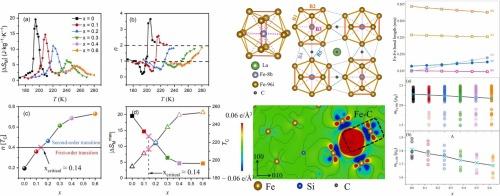Phase transition and magnetocaloric effect of LaFe11.5Si1.5Cx compounds: experiments and density functional theory calculations
IF 6.3
2区 材料科学
Q2 CHEMISTRY, PHYSICAL
引用次数: 0
Abstract
The itinerant-electron metamagnetic (IEM) transition is a crucial phenomenon in first-order transition magnetocaloric materials. However, most magnetocaloric materials experience a transition from first to second order, weakening their IEM transition and magnetocaloric effect. This study uses experiments and density functional theory (DFT) calculations to elucidate phase transition and magnetocaloric effect in C-doped La(Fe,Si)13 compounds. The LaFe11.5Si1.5Cx alloys exhibit a cubic NaZn13-type 1:13 primary phase. The critical phase transition from first order to second order occurs at x = 0.14. As x increases from 0 to 0.6, the maximum magnetic entropy change () decreases from 19.6 to 4.5 J∙kg-1∙K-1 at , while the Curie temperature (Tc) rises from 193 to 251 K. DFT calculations reveal that interstitial C-24d atom reduces the magnetic moment of 4 adjacent Fe-96i atoms, contracts the B1, B2 and B3 intra-icosahedron Fe-Fe bonds, but elongates the B4 and B5 inter-icosahedron bonds. Furthermore, the phase transition from first order to second order is attributed to the formation of Fe-C covalent bonds and localization of Fe 3d electrons, due to the strong electronic hybridization of the C 2p and Fe 3d states. C-doping weakens the IEM transition by shifting the minimum in the minority density of states (DOS) channels from the Fermi level to lower energies. This study offers valuable insights into the phase transition and IEM transition behaviors and paves the way for designing high performance magnetocaloric alloys.

lafe11.5 si1.5 5cx化合物的相变和磁热效应:实验和密度泛函理论计算
流动电子变磁(IEM)跃迁是一阶跃迁磁热材料中的一个重要现象。然而,大多数磁热材料经历了从一级到二级的转变,削弱了它们的IEM转变和磁热效应。本研究利用实验和密度泛函理论(DFT)计算来阐明掺杂c的La(Fe,Si)13化合物的相变和磁热效应。lafe11.5 si1.5 5cx合金表现为立方nazn13型1:13初生相。从一阶到二阶的临界相变发生在x = 0.14处。μ0∆H=2T时,随着x从0增加到0.6,μ0∆H=2T时的最大磁熵变(ΔSMmaxΔSMmax)从19.6减小到4.5 J∙kg-1∙K-1,居里温度(Tc)从193 K上升到251 K。DFT计算表明,间隙C-24d原子降低了相邻4个Fe-96i原子的磁矩,收缩了B1、B2和B3原子的二十面体内Fe-Fe键,但延长了B4和B5原子的二十面体内Fe-Fe键。此外,从一阶到二阶的相变归因于Fe-C共价键的形成和Fe 3d电子的局域化,由于c2p和Fe 3d态的强电子杂化。c掺杂通过将少数态密度(DOS)通道的最小值从费米能级转移到更低的能量,从而减弱了IEM跃迁。该研究为研究相变和IEM相变行为提供了有价值的见解,并为设计高性能磁热合金铺平了道路。
本文章由计算机程序翻译,如有差异,请以英文原文为准。
求助全文
约1分钟内获得全文
求助全文
来源期刊

Journal of Alloys and Compounds
工程技术-材料科学:综合
CiteScore
11.10
自引率
14.50%
发文量
5146
审稿时长
67 days
期刊介绍:
The Journal of Alloys and Compounds is intended to serve as an international medium for the publication of work on solid materials comprising compounds as well as alloys. Its great strength lies in the diversity of discipline which it encompasses, drawing together results from materials science, solid-state chemistry and physics.
 求助内容:
求助内容: 应助结果提醒方式:
应助结果提醒方式:


